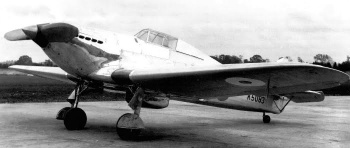Post by Diarist on Sept 6, 2014 22:24:52 GMT 1
Design and development
At the time that the Hurricane was developed RAF Fighter Command consisted of just 13 squadrons, each equipped with either the Hawker Fury, Hawker Demon, or the Bristol Bulldog, all biplanes with fixed-pitch wooden propellers and non-retractable undercarriages. Sydney Camm's design to meet F.7/30, the Hawker P.V.3, was essentially a scaled-up version of the Fury and was not among the proposals submitted to the Air Ministry selected for building as a government sponsored prototype. After the rejection of the P.V.3 Camm started work on a cantilever monoplane with a fixed undercarriage armed with four machine guns and powered by the Rolls-Royce Goshawk. Detail drawings were finished by January 1934 but failed to impress the Air Ministry enough for a prototype to be ordered. Camm's response was to further develop the design, introducing a retractable undercarriage and replacing the unsatisfactory Goshawk with a new Rolls-Royce design, the PV-12, later to become famous as the Merlin. In August 1934, a one-tenth scale model was made and sent to the National Physical Laboratory at Teddington. A series of wind tunnel tests confirmed the aerodynamic qualities of the design were in order, and in September Camm approached the Air Ministry again. This time the response was favourable, and a prototype of the "Interceptor Monoplane" was ordered.
In November 1934 the Air Ministry issued Specification F.5/34 which, drawing on the work of Squadron Leader Ralph Sorley, called for fighter aircraft to be armed with eight guns. However, by this time, work had progressed too far to immediately modify the planned four-gun installation. By January 1935, a wooden mock-up had been finished, and although a number of suggestions for detail changes were made construction of the prototype was approved, and a new specification (F.36/34) was written around the design.
Source: Wikipedia - en.wikipedia.org/wiki/Hawker_Hurricane
At the time that the Hurricane was developed RAF Fighter Command consisted of just 13 squadrons, each equipped with either the Hawker Fury, Hawker Demon, or the Bristol Bulldog, all biplanes with fixed-pitch wooden propellers and non-retractable undercarriages. Sydney Camm's design to meet F.7/30, the Hawker P.V.3, was essentially a scaled-up version of the Fury and was not among the proposals submitted to the Air Ministry selected for building as a government sponsored prototype. After the rejection of the P.V.3 Camm started work on a cantilever monoplane with a fixed undercarriage armed with four machine guns and powered by the Rolls-Royce Goshawk. Detail drawings were finished by January 1934 but failed to impress the Air Ministry enough for a prototype to be ordered. Camm's response was to further develop the design, introducing a retractable undercarriage and replacing the unsatisfactory Goshawk with a new Rolls-Royce design, the PV-12, later to become famous as the Merlin. In August 1934, a one-tenth scale model was made and sent to the National Physical Laboratory at Teddington. A series of wind tunnel tests confirmed the aerodynamic qualities of the design were in order, and in September Camm approached the Air Ministry again. This time the response was favourable, and a prototype of the "Interceptor Monoplane" was ordered.
In November 1934 the Air Ministry issued Specification F.5/34 which, drawing on the work of Squadron Leader Ralph Sorley, called for fighter aircraft to be armed with eight guns. However, by this time, work had progressed too far to immediately modify the planned four-gun installation. By January 1935, a wooden mock-up had been finished, and although a number of suggestions for detail changes were made construction of the prototype was approved, and a new specification (F.36/34) was written around the design.
Source: Wikipedia - en.wikipedia.org/wiki/Hawker_Hurricane

